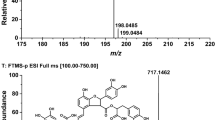Abstract
A new method applying sensitive and selective liquid chromatography coupled with mass spectrometry (LC/MS/MS) for analyzing tertiary-butylhydroquinone (TBHQ) and its metabolites in rat serum was validated. Using an extracted ion chromatogram (EIC) of m/z 149, free TBHQ was observed in rat serum after dosing TBHQ at 350 mg/kg to male and female Sprague–Dawley (SD) rats. Four major metabolites of TBHQ were identified—a TBHQ-sulfate, two TBHQ-sulfate-derived substances and a TBHQ-glucuronide through MSn spectra. Besides its simplicity, the sample treatment allows one to obtain a very good recovery of analysts, namely around 95%. This result suggests that the method described here is useful for the analysis of TBHQ and its metabolites in rat serum. Moreover, the metabolism of TBHQ was investigated using the method. After oral administration, TBHQ appear to be more completely absorbed and bio-transformed by males than females, which may result in higher acute oral toxicity of TBHQ for males than females.









Similar content being viewed by others
References
Rojas M, Brewer M (2007) Effect of natural antioxidants on oxidative stability of cooked, refrigerated beef and pork. J Food Sci 72:282–288
Gámez-Mezaa B, Noriega-Rodrígueza J, Medina-Juáreza LA, Ortega-Garcíaa J, Cázarez-Casanovaa R, Angulo-Guerrerob O (1999) Antioxidant activity in soybean oil of extracts from Thompson grape bagasse. J Am Oil Chem Soc 76:1445–1447
Min DB, Schweizer D (1983) Gas chromatographic determination of butylated hydroxyanisole, butylated hydroxytoluene and tertiary butyl hydroquinone in soybean oil. J Food Sci 48:73–74
Okubo T, Yokoyama Y, Kano K, Kano I (2003) Cell death induced by the phenolic antioxidant tert-butylhydroquinone and its metabolite tert-butylquinone in human monocytic leukemia U937 cells. Food Chem Toxicol 41:679–688
Hirokazu H, Mitsuhiro O, Kiyoe O, Sadako K, Tetsuo A (2003) Increase of antioxidative potential by tert-butylhydroquinone protects against cell death associated with 6-hydroxydopamine-induced oxidative stress in neuroblastoma SH-SY5Y cells. Mol Brain Res 119:125–131
Mohamed H (2003) Testicular toxicity of dibromoacetonitrile and possible protection by tertiary butylhydroquinone. Pharmacol Res 47:509–515
Ammawath W, Che MY, Baharin B, Abdul-Rahman R (2004) A new method for determination of tert-butylhydroquinone (TBHQ) in RBD palm olein with FTIR spectroscopy. J Food Lipids 11:266–277
Min-hua Y, Hsiu-jung L, Youk-meng C (2002) A rapid gas chromatographic method for direct determination of BHA, BHT and TBHQ in edible oils and fats. Food Res Int 35:627–633
Christian P, Liliane M (2002) Quantification of synthetic phenolic antioxidants in dry foods by reversed-phase HPLC with photodiode array detection. Food Chem 77:93–100
Warner K, Dunlap C (2006) Effects of expeller-pressed/physically refined soybean oil on frying oil stability and flavor of french-fried potatoes. J Am Oil Chem Soc 83:435–441
Yueqing G, Qingcui C, Liang F, Ting W, Jiannong Y (2006) Determination of phenolic antioxidants by micellar electrokinetic capillary chromatography with electrochemical detection. Food Chem Toxicol 94:157–162
Wen H, Hai N, Bi S, Minli Y, Jixin J (2007) HPLC coupled to ion trap-ms/ms for analysis of tertiary-butylhydroquinone in edible oil samples. J Food Lipids (in press)
Ikeda G, Sapienza P, Ross I (1998) Distribution and excretion of radiolabelled tert-butylhydroquinone in Fischer 344 rats. Food Chem Toxicol 36:907–914
Chen HX, Chen Y, Du P, Han FM, Wang H, Zhang HS (2006) Sensitive and specific liquid chromatographic–tandem mass spectrometric assay for atropine and its eleven metabolites in rat urine. J Pharm Biomed Anal 40:142–150
Aresta A, Carbonara T, Palmisano F, Zambonin C (2006) Profiling urinary metabolites of naproxen by liquid chromatography–electrospray mass spectrometry. J Pharm Biomed Anal 41:1312–1316
Astill B, Terhaar C, Krasavage W, Wolf G, Roudabush R, Fassett D (1975) Safety evaluation and biochemical behavior of monotertiarybutylhydroquinone. J Am Oil Chem Soc 52:53–58
Acknowledgments
Financial support of this research was from the National Key Technologies R&D Program of China with grant no. 2001BA804A21. Sincere thanks are to Dr Pengpenhao at Peking University for providing technical assistance in the experimental studies.
Author information
Authors and Affiliations
Corresponding author
About this article
Cite this article
Huang, W., Gu, Y. & Niu, H. Determination of Tertiary-butylhydroquinone and Its Metabolites in Rat Serum by Liquid Chromatography–Ion Trap Mass Spectrometry. Lipids 43, 281–288 (2008). https://doi.org/10.1007/s11745-007-3135-4
Received:
Accepted:
Published:
Issue Date:
DOI: https://doi.org/10.1007/s11745-007-3135-4




